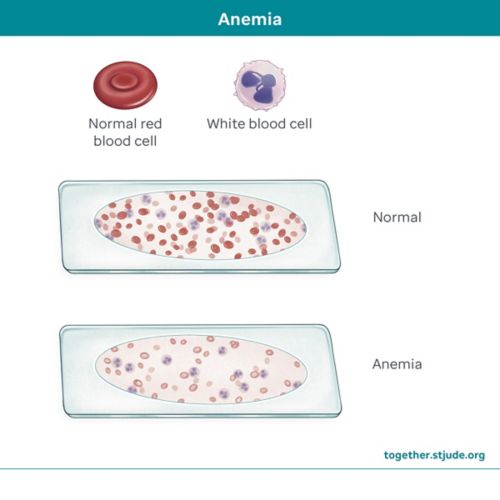Anemia is a condition where your body does not have enough healthy red blood cells. These cells carry oxygen from the lungs to the rest of your body. When there are not enough red blood cells, your body does not get the oxygen it needs to work properly. Red blood cells develop in the bone marrow, the soft, spongy tissue at the center of your bones.
Signs and symptoms of anemia include:
- Feeling weak and tired (fatigue)
- Dizziness or fainting
- Shortness of breath
- Fast heartbeat
- Pale or yellow skin
- Headache
- Cold hands or feet
Anemia can happen for different reasons, which include:
- Increased breakdown of red blood cells
- Not having enough of certain nutrients, such as iron, folic acid, and vitamin B12
- Disorders of the blood or bone marrow
- Cancer of the bone marrow, including leukemia and lymphoma
- Chemotherapy that damages the bone marrow
- Radiation to large areas of the body or to the bones (damages the bone marrow)
- Blood loss from an injury, surgery, or heavy menstrual periods
- Diseases of the kidney, liver, digestive tract, thyroid, or immune system
Anemia is diagnosed based on your child’s medical history, physical exam, and lab tests. Lab tests may include:
- Complete blood count (CBC) to look for signs of anemia. A CBC test measures:
- The number of red blood cells, white blood cells, and platelets
- The size of red blood cells
- Hematocrit, which shows how much of the blood is made up of red blood cells
- Hemoglobin, a protein in your blood that carries oxygen
- Peripheral blood smear to look at blood cells under a microscope
- Reticulocyte count to measure the number of young red blood cells in your child’s body. A high reticulocyte count means the bone marrow has to make more cells to replace damaged ones.
Your care provider may order more tests to determine the type of anemia and its cause.
Your child’s treatment will depend on the cause of anemia. If anemia is caused by an underlying condition, treatment of that disease may help improve the anemia. In some cases, your child’s care provider may refer your child to a hematologist, a doctor who diagnoses and treats blood disorders.
Treatments for anemia may include:
- Vitamin and mineral supplements such as iron, folic acid, or vitamin B12
- Red blood cell transfusion to give red blood cells by vein
- Medicines to help your child’s body make more red blood cells or to keep the immune system from attacking stem cells
A stem cell (bone marrow) transplant may be needed if anemia is caused by a condition that affects how the red blood cells are made in the bone marrow.
To help manage anemia, be sure your child:
- Eats a balanced diet with enough iron, vitamins, and other nutrients.
- Gets the right amount of sleep each day (including naps):
- Infants: 12–16 hours
- Ages 1–2 years: 11–14 hours
- Ages 3–5 years: 10–13 hours
- Ages 6–12 years: 9–12 hours
- Ages 13–18 years: 8–10 hours
- Balances rest with physical activity. Keep in mind that too much bed rest can make your child feel weak.
The prognosis for anemia depends on the type of anemia and its cause. With the right treatment, the prognosis can be excellent. But untreated anemia can be serious and sometimes life threatening.
Questions to ask your care team




